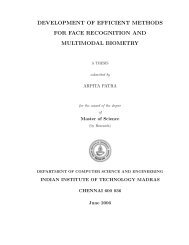The Enigma of Group Theory - Department of Computer Science ...
The Enigma of Group Theory - Department of Computer Science ...
The Enigma of Group Theory - Department of Computer Science ...
You also want an ePaper? Increase the reach of your titles
YUMPU automatically turns print PDFs into web optimized ePapers that Google loves.
http://www.cs.bris.ac.uk University <strong>of</strong> Bristol, <strong>Department</strong> <strong>of</strong> <strong>Computer</strong> <strong>Science</strong><br />
way we will finally deduce that<br />
ɛ0 = (AL)(BF)(CH)(DE)(GX)(IR)(JO)(KP)(MZ)(NW)(QU)(ST)(VY),<br />
ɛ1 = (AK)(BQ)(CW)(DM)(EH)(FJ)(GT)(IZ)(LP)(NV)(OR)(SX)(UY),<br />
ɛ2 = (AJ)(BN)(CK)(DZ)(EW)(FP)(GX)(HS)(IY)(LM)(OQ)(RU)(TV),<br />
ɛ3 = (AF)(BQ)(CY)(DL)(ES)(GX)(HV)(IN)(JP)(KW)(MT)(OU)(RZ),<br />
ɛ4 = (AK)(BN)(CJ)(DG)(EX)(FU)(HS)(IZ)(LW)(MR)(OY)(PQ)(TV),<br />
ɛ5 = (AK)(BO)(CJ)(DN)(ER)(FI)(GQ)(HT)(LM)(PX)(SZ)(UV)(WY).<br />
We now need to use this information to deduce the value <strong>of</strong> ρ1, etc. So for the rest <strong>of</strong> this section we<br />
assume we know ɛj for j = 0, . . . , 5, and so we mark it in blue.<br />
Recall that we have,<br />
ɛj = τ · (σ i1+j ρ1σ −i1−j ) · (σ i2 ρ2σ −i2 ) · (σ i3 ρ3σ −i3 ) · ϱ ·<br />
· (σ i3 ρ3 −1 σ −i3 ) · (σ i2 ρ2 −1 σ −i2 ) · (σ i1+j ρ1 −1 σ −i1−j ) · τ<br />
We now assume that no stepping <strong>of</strong> the second rotor occurs during the first six encryptions under the<br />
day setting. This occurs with quite high probability, namely 20/26 ≈ 0.77. If this assumption turns out<br />
to be false we will notice this in our later analysis and it will mean we can deduce something about the<br />
(unknown to us at this point) position <strong>of</strong> the notch on the first rotor.<br />
Given that we know the day settings, so that we know τ and the values <strong>of</strong> i1, i2 and i3 (since we are<br />
assuming k1 = k2 = 0 for 0 ≤ j ≤ 5), we can write the above equation for 0 ≤ j ≤ 5 as<br />
λj = σ −i1−j · τ · ɛj · τ · σ i1+j<br />
= ρ1 · σ −j · γ · σ j · ρ1 −1 .<br />
Where λj is now known and we wish to determine ρ1 for some fixed but unknown value <strong>of</strong> γ. <strong>The</strong><br />
permutation γ is in fact equal to<br />
γ = (σ i2−i1 ρ2σ −i2 ) · (σ i3 ρ3σ −i3 ) · ϱ · (σ i3 ρ3 −1 σ −i3 ) · (σ i2 ρ2 −1 σ i1−i2 ).<br />
In our example we get the following values for λj,<br />
We now form, for j = 0, . . . , 4,<br />
λ0 = (AD)(BR)(CQ)(EV)(FZ)(GP)(HM)(IN)(JK)(LU)(OS)(TW)(XY),<br />
λ1 = (AV)(BP)(CZ)(DF)(EI)(GS)(HY)(JL)(KO)(MU)(NQ)(RW)(TX),<br />
λ2 = (AL)(BK)(CN)(DZ)(EV)(FP)(GX)(HS)(IY)(JM)(OQ)(RU)(TW),<br />
λ3 = (AS)(BF)(CZ)(DR)(EM)(GN)(HY)(IW)(JO)(KQ)(LX)(PV)(TU),<br />
λ4 = (AQ)(BK)(CT)(DL)(EP)(FI)(GX)(HW)(JU)(MO)(NY)(RS)(VZ),<br />
λ5 = (AS)(BZ)(CV)(DO)(EM)(FR)(GQ)(HK)(IL)(JT)(NP)(UW)(XY).<br />
µj = λj · λj+1,<br />
= ρ1 · σ −j · γ · σ −1 · γ · σ j+1 · ρ1 −1 ,<br />
= ρ1 · σ −j · δ · σ j · ρ1 −1 ,<br />
where δ = γ · σ −1 · γ · σ is unknown. Eliminating δ via δ = σ j−1 ρ1 −1 µj−1ρ1σ −j+1 we find the following<br />
equations for j = 1, . . . , 4,<br />
µj = (ρ1 · σ −1 · ρ1 −1 ) · µj−1 · (ρ1 · σ · ρ1 −1 ),<br />
= α · µj−1 · α −1 ,<br />
where α = ρ1 · σ −1 · ρ1 −1 . Hence, µj and µj−1 are conjugate and so by Fact 1 have the same cycle structure.<br />
For our example we have<br />
µ0 = (AFCNE)(BWXHUJOG)(DVIQZ)(KLMYTRPS),<br />
µ1 = (AEYSXWUJ)(BFZNO)(CDPKQ)(GHIVLMRT),<br />
µ2 = (AXNZRTIH)(BQJEP)(CGLSYWUD)(FVMOK),<br />
µ3 = (ARLGYWFK)(BIHNXDSQ)(CVEOU)(JMPZT),<br />
µ4 = (AGYPMDIR)(BHUTV)(CJWKZ)(ENXQSFLO).<br />
11










